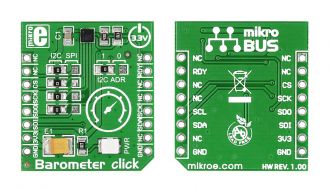
We strongly encourage users to use Package manager for sharing their code on Libstock website, because it boosts your efficiency and leaves the end user with no room for error. [more info]

Rating:
Author: MIKROE
Last Updated: 2018-11-07
Package Version: 1.0.0.1
mikroSDK Library: 1.0.0.0
Category: Pressure
Downloaded: 6674 times
Followed by: 3 users
License: MIT license
Barometer Click board carries LPS25HB, a piezoresistive absolute pressure sensor which communicates through I2C or SPI. It is guaranteed to operate over a temperature range extending from -30 to +105 °C.
This example demonstrates the functionality of the Barometer Click board using I2C. Board is designed to work with 3.3V only.
Do you want to subscribe in order to receive notifications regarding "Barometer click" changes.
Do you want to unsubscribe in order to stop receiving notifications regarding "Barometer click" changes.
Do you want to report abuse regarding "Barometer click".

Front and back view of Barometer 2 Click Board designed in mikroBUS form factor.
View full image